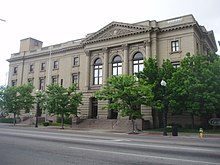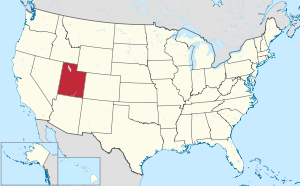|
Weber County, Utah
Weber County (/ˈwiːbər/ WEE-bər) is a county in the U.S. state of Utah. As of the 2020 census, the population was 262,223,[1] making it Utah's fourth-most populous county. Its county seat and largest city is Ogden,[2] the home of Weber State University. The county was named after a fur trapper John Weber. Weber County is part of the Ogden-Clearfield, UT Metropolitan Statistical Area as well as the Salt Lake City-Provo-Ogden, UT Combined Statistical Area. HistoryThe Weber Valley was visited by many trappers seeking beavers and muskrats along its streams. One of the first on record reached the area in 1824, traveling from Fort Bridger. He reported that the Bear River flowed into a salt bay. Peter Skene Ogden passed through in 1826, representing the Hudson's Bay Company. He traded in this area for several years, near present-day North Ogden. John C. Frémont explored the Weber Valley in 1843 and made maps of the area. The Fremont reports encouraged readers to seek their fortunes in the western frontier. Miles Goodyear was a fur trapper who constructed a way station on the Weber River in 1845. In 1847 he sold it to incoming Mormon pioneers. James Brown purchased and changed the site's name to Brownsville (later changed to Ogden).[3] After the Mormon pioneers began filling out into the future state of Utah, the fledgling government (as of 1849 known as State of Deseret) began a system of government. On January 31, 1850, the legislature provided for the creation of six counties to generally cover the area, named in this order:
The county boundaries were better defined by the 1852 Utah Territory legislature. The borders were adjusted by subsequent acts in 1855, 1856, and 1862. The creation of Nevada Territory in 1862 also administratively reduced the county's territory significantly since its 1852 description had it running to the Sierra Nevada mountains in central California. A final adjustment in 1880 concerning the various lands in the Great Salt Lake area brought the county's borders to their present configuration.[5] As of the 1852 description, the original Weber County stretched from California in the west, to the Oregon boundary on the north, to a point in the middle Davis County in the south.[6] As Nevada and the State of Utah evolved, Weber County was trimmed so that it now occupies a stretch of the Wasatch Front, part of the eastern shores of Great Salt Lake, and much of the rugged Wasatch Mountains. GeographyThe county extends from high in the Wasatch Range in the east into a portion of the Great Salt Lake to the west, where the county's elongated point exists. The Weber and Ogden rivers and their tributaries run through its valleys.[7] The Weber County Surveyor's office divides the county into two regions, the "Lower Valley" and the "Upper Valley", divided by the ridge of the Wasatch front range south through the county. Lower Valley, adjacent to the Lake, is the county's more populous part. The Upper Valley consists mostly of the Ogden Valley, the watershed of the Ogden River. The county's highest elevation is Willard Peak in the Wasatch Mountains, at 9,763 ft (2,976 m) ASL.[8] The county has an area of 659 square miles (1,710 km2), of which 576 square miles (1,490 km2) is land and 83 square miles (210 km2) (13%) is water.[9] It is the second-smallest county in Utah by land area and third-smallest by total area. Major highwaysMany roads in Weber County are named in a numerical grid system with an street name difference of 800 corresponding to one mile in a similar vein to Salt Lake County. In April 1947, North Ogden was the first municipality in Weber County to adopt the grid system, resulting in the north/south demarcator (1st Street) being placed in the northern half of the county. The east/west demarcator was selected as Wall Avenue which runs parallel to downtown Ogden.[10] Adjacent counties
Protected areas
Lakes
Demographics
2020 censusAccording to the 2020 United States census[15] and 2020 American Community Survey,[16] there were 262,223 people in Weber County with a population density of 429.1 people per square mile (165.7/km2). Among non-Hispanic or Latino people, the racial makeup was 193,889 (73.9%) White, 3,209 (1.2%) African American, 1,394 (0.5%) Native American, 3,603 (1.4%) Asian, 948 (0.4%) Pacific Islander, 1,014 (0.4%) from other races, and 9,424 (3.6%) from two or more races. 48,742 (18.6%) people were Hispanic or Latino. There were 131,864 (50.29%) males and 130,359 (49.71%) females, and the population distribution by age was 72,631 (27.7%) under the age of 18, 157,239 (60.0%) from 18 to 64, and 32,353 (12.3%) who were at least 65 years old. The median age was 32.9 years. There were 89,595 households in Weber County with an average size of 2.93 of which 64,544 (72.0%) were families and 25,051 (28.0%) were non-families. Among all families, 48,636 (54.3%) were married couples, 5,660 (6.3%) were male householders with no spouse, and 10,248 (11.4%) were female householders with no spouse. Among all non-families, 19,876 (22.2%) were a single person living alone and 5,175 (5.8%) were two or more people living together. 33,909 (37.8%) of all households had children under the age of 18. 64,756 (72.3%) of households were owner-occupied while 24,839 (27.7%) were renter-occupied. The median income for a Weber County household was $71,275 and the median family income was $80,961, with a per-capita income of $29,186. The median income for males that were full-time employees was $53,678 and for females $38,512. 8.6% of the population and 5.7% of families were below the poverty line. In terms of education attainment, out of the 158,841 people in Weber County 25 years or older, 13,423 (8.5%) had not completed high school, 46,466 (29.3%) had a high school diploma or equivalency, 59,079 (37.2%) had some college or associate degree, 27,871 (17.5%) had a bachelor's degree, and 12,002 (7.6%) had a graduate or professional degree. 2010 censusAs of the 2010 United States Census, there were 231,236 people in the county, organized into 78,784 households and 57,867 families.[17] The population density was 351 people per square mile (136 people/km2). There were 86,187 housing units at an average density of 131 units per square mile (51 units/km2).[17] The racial makeup of the county was 85.2% White, 1.4% Black or African American, 1.3% Asian, 0.8% Native American, 0.3% Pacific Islander, 6.59% from other races, and 3.0% from two or more races. 16.7% of the population were Hispanic or Latino of any race.[17] The median income for a household in the county was $62,036, and the median income for a family was $71,359. Males had a median income of $49,081 versus $34,954 for females. The per capita income for the county was $25,275. 12.1% of the population and 8.7% of families were below the poverty line. Out of the total population, 15.4% of those under 18 and 8.5% of those 65 and older lived below the poverty line. In the 2010 census, 67.0% of people over 16 were in labor, and 33.0% were not in labor. The unemployment rate was 3.2%.[17] Age distribution
The median age was 30.7 years. For every 100 females, there were 100.7 males. For every 100 females aged 18 and over, there were 99.0 males.[17] AncestryAs of 2017, the largest self-identified ancestry groups in Weber County, Utah were:[18]
Politics and governmentLike most of Utah, Weber County voters usually vote Republican. In no national election since 1964 has the county selected the Democratic Party candidate.
EducationTertiary institutions and organizations of education in Weber County: The two K-12 school districts in the county are Ogden City School District and Weber School District.[33] There is also a state-operated school, Utah Schools for the Deaf and the Blind. CommunitiesCitiesTownsTownshipsCensus-designated placesCensus county divisionUnincorporated communitiesNotable residents
See alsoReferences
Further reading
External links
|
|||||||||||||||||||||||||||||||||||||||||||||||||||||||||||||||||||||||||||||||||||||||||||||||||||||||||||||||||||||||||||||||||||||||||||||||||||||||||||||||||||||||||||||||||||||||||||||||||||||||||||||||||||||||||||||||||||||||||||||||||||||||||||||||||||||||||||||||||||||||||||||||||||||||||||||||||||||||||||||||||||||||||||||||||||||||||||||||||||||||||||||||||||||||||||||||||||||||||||||||||||||||||||||||||||||||||||||||||||||||||||||||||||||||||||||||||||||||||||||||||||||||||||||||||||||||||



